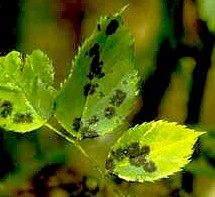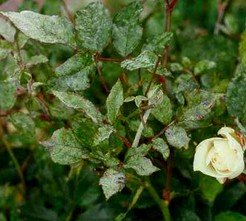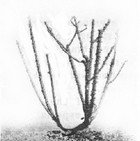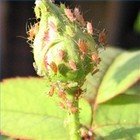Natural Remedies for Rose Diseases: Mildew, Rust, Black Spot, Canker
Roses will suffer from black spot from time to time, as well as from thrips, aphids, mealy bugs, and other rose-eating bests like the chafer beetle and the red spider mite. Control these insects by either using predatory insects, such as lady bugs, or you can use natural pesticides and insecticides. White oil is also very good in getting rid of rose scale.
Rose Diseases: Black Spot
Sometimes even new leaves
emerge that are affected. Because black spot
causes the roses to lose its leaves, the plant soon becomes weak if it
goes unchecked. The ultimate result is that your rose plant will die.
The situation is made worse when humid weather is around and you have a
wet summer.
In
order to get rid of the black spot you need to reduce the humidity
factor of your growing roses, and you do this by making
sure that when
you plant them out initially they are not over crowded and try not to
underplant too closely with annuals and other small plants.
Make sure that your roses have full sun and do not water them in the late afternoon so that the leaves remain wet for a long time. Also avoid watering your roses overhead during the summer heat. When the leaves are wet these damp conditions help spread the fungal spores.
Good hygiene is also important for controlling black spot. So rake up any fallen leaves and remove any prunings from the area. When pruning, prune off all old foliage as the spores reside on the dead leaves over winter
If you see any black spot on your roses remove them and burn them. Do not put these into your compost heap.
Roses are heavy feeders so
give them regular doses of fertilizer every 6 weeks throughout the
growing season. This keeps them healthy and therefore makes them
resistant to black spot, as well as other rose diseases. Not only that,
but roses that
are well fed and given compost dressings often will out
grow black
spot.
Also mulch your growing
roses well. A mulch of lucerne hay and cow
manure is an excellent mulch. Do
this every spring, or late winter. Mulching your roses will prevent the
black-spot
spores from splashing up on to your plants.
Spraying the leaves with a foliar feed is also beneficial. Liquid seaweed fertilizer increases rose health and again helps them resist disease.
Finally add some wood ash to your soil in winter and dig in lightly around your rose plants as black spot often occurs when there is a shortage of potash in the soil.
In the end, none of the
above will prevent black spot for occuring, but it will help to reduce
its severity.
Natural Sprays and Organic Control for Black Spot on your Roses
 If
you need to spray
your
foliage for black spot use an organic spray. We use a strong
chamomile-nettle tea
spray every
week during the hot summer months and sometimes beyond.
If
you need to spray
your
foliage for black spot use an organic spray. We use a strong
chamomile-nettle tea
spray every
week during the hot summer months and sometimes beyond.
This is using 1 part stinging nettles to 1 part chamomile flowers. Let it steep in a bucket of boiling water for 10 days.
When you want to use it add 1 teaspoon baking soda for every 2 liters of spray. Or you can use baking soda spray on its own, using 1 dessertspoon of baking soda to 1 liter of water.
Another excellent solution to use is cider vinegar in water. Now, some of you may want to question this, as black spot usually grows where a near neutral pH situation occurs. This is why any alterations to the pH will work. I can tell you that this also works like a dream. I use it when I don't have my chamomile-nettle tea.Cider Vinegar Recipe for Black Spot
Mix 3 tablespoons of cider vinegar (I always buy Braggs as it has the mother culture) to 5 quarts ( 5 liters) of water. Add 1 teaspoon of vegetable oil and a good squirt of soft soap to make sure that your organic spray sticks to the leaves. Spray on plant early morning or evening to prevent leaf burn. Reapply as necessary, and always after it has rained, once the leaves are dry.Rose Diseases: Mosaic Disease
This is a virus that enters the rose bush when it was grafted. It isn't a serious condition, and your roses should bloom normally, so you don't have to treat it at all.
However, you should avoid contamination of other roses. So when you use your sacateurs on this rose bush make sure that you disinfect them before using it on others. If you find that the rose bush has been horribly disfigured and marked by the mosaic disease it will then best to dig it up and replace it.
Rose Diseases: Mildew
 You
will notice rose
mildew, a very common rose disease, by powdery mould on the young rose
leaves and later on the stems.
You
will notice rose
mildew, a very common rose disease, by powdery mould on the young rose
leaves and later on the stems. Usually, if your roses are going to get mildew it will happen twice a season.
Firstly, when it is the initial growing season where the mildew is fairly mild when it does strike.
Then later in the full swing of summer when the second attack is very strong. Here not just the leaves are affected, as in the first round of mildew, but this time the stems are affected as well.
The second attack will take place in the hottest months of summer. If left untreated, the mildew will continue through to the fall where white cottony tufts occur on your rose bushes which carry the winter spores.
A natural remedy for rose mildew again is using the stinging nettle-chamomile spray as per the above instructions.
Ordinary baking soda is also a good natural fungicide for treating mildew on roses as well as other plants.
However, an equally good homemade remedy for mildew is ordinary milk. Dilute 1 part milk in 7 parts water and spray on your roses. Apply again if it rains, but wait for the leaves to dry first. Apply again, when necessary.
Some roses are more prone to rose mildew than others. Tea roses, China roses and Wichuraianas roses are relatively free from this disease.
Rose Diseases: False Rose Mildew
Thankfully, this is not a common rose disease, as when it hits your roses, they will virtually curl up their toes and die overnight.It is also known as Black Mildew. New shoots become limp and die back, new leaves drop from the stems at the least touch. Fungal patches of brown-yellow appear on the front of the leaves, and sometimes there is even a white mould on the back of the leaves.
Spray your roses with a Bordeaux mixture as soon as you see this fungus appearing. You will probably lose young stock, but if caught early you may be lucky to save older rose plants from the disease.
Rose Diseases: Rose Rust
Now rust is a common rose disease, appearing towards the end of summer, beginning of fall.Deep orange rust like patches first appear on the stems, and then move onto the leaves. In the fall the winter spores are produced. Now instead of the orange-rust patches, black spots are scattered on the underside of the leaves.
These fungal spores will lie dormant during the winter, and if they find the right conditions, they will infect the stems of the roses to produce those tell-tale bright orange-rust patches during the summer.
To try and prevent this disease from spreading, remove any of the rust infected leaves and burn them. Do not add them to your compost heaps.
When spring comes spray your roses with a Bordeaux mixture to prevent the rust from appearing later on. Again, baking soda in water will do the trick as well.
If you find that during those summer months your rose stems are affected with rust, cut those out too, and burn them. If you find that you cannot cut out certain stems, as it would spoil the look of the plant, then rub them down with some cotton wool dipped in methylated spirits.
Rose Diseases: Parasitic Canker
This type of rose disease can be found on older roses, especially 2 - 3 year old wood, normally at the base of the plant where the wood has swollen and cankered patches. It may be so bad that the affected area may even split right open and you can see traces of the fungus orginating from there.Often these affected areas are from where prior pruning has taken place. The fungus spores having entered the areas where damage has been done to the stems.
This is why it is so important that one prunes roses properly, and treats the cut ends correctly afterwards. Using methylated spirits is one way of protecting your roses from any fungal spores that might be lurking.
You can Add your own Comments, Tips and Ideas on Rose Diseases Here!
We have lots of pages where you can contribute to throughout this website. We love hearing from our readers, and hope you will be one of those we hear from too. Look around our homesteading website. If you have some comments, tips and ideas about growing roses of your own, please submit them. All you need to do is type and submit. We will do the rest!
Leave a Comment
Do you have anything that you would like to add after reading this page? We would love to hear your thoughts. If you can add additional information to what has been written here you will be adding value to the website! No need to have any special skills - just type and submit. We will do the rest!







New! Comments
Do you have something of value to add? Leave me a comment in the box below.